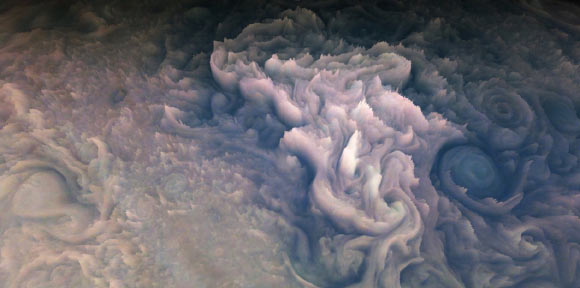Intensity data of visible light seen by a camera can be plotted as a 3D elevation landscape. The new computer animation, created by citizen scientist and professional mathematician Dr. Gerald Eichstädt and his colleagues from Caltech and the Planetary Science Institute, shows a flight over such a landscape for processed, red-filtered image data collected by the JunoCam instrument onboard NASA’s Juno spacecraft during its 43rd close Jupiter flyby.
“The Juno mission provides us with an opportunity to observe Jupiter in a way which is essentially inaccessible by Earth-based telescopic observations,” Dr. Eichstätd said.
“We can look at the same cloud features from very different angles within only a few minutes.”
“This has opened up a new opportunity to derive 3D elevation models of Jupiter’s cloud-tops.”
“The images of the wonderful chaotic storms on Jupiter seem to come to life, showing clouds rising at different altitudes.”
Using the different ways in which sunlight is reflected and scattered by clouds, Dr. Eichstät and co-authors pinpointed the elevation of the cloud-tops observed.
“Solar illumination is most intense for clouds in the upper atmosphere,” they explained.
“Deeper in the atmosphere, more light is absorbed — particularly by methane — before being scattered back up to the camera by the cloud tops.”

This image shows ‘frosted cupcake’ clouds in the atmosphere of Jupiter. The image was taken at a nominal altitude of 13,536.3 km above Jupiter’s cloud tops. image credit: NASA / JPL-Caltech / SwRI / MSSS / Gerald Eichstädt.
Understanding the relative heights of the spiky pillars within the swirls will help the scientists to unveil in more detail the elements that compose them.
“From theoretical models, the clouds are expected to be composed of different chemical species, ammonia, ammonium hydrosulfide, and water ice from top to bottom,” Dr. Eichstädt said.
“Once we calibrate our data thanks to other measurements of the same cloud tops, we will test and refine the theoretical predictions and have a better 3D picture of the chemical composition.”
The authors presented their findings this week at the Europlanet Science Congress (EPSC) 2022 in Granada, Spain.
_____
Gerald Eichstädt et al. Long-Baseline Observations with JunoCam. EPSC Abstracts 16; EPSC2022-1124







